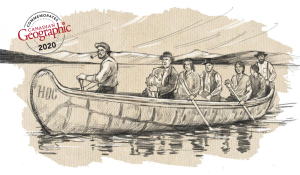
Science & Tech
20 Canadian innovations you should know about
Celebrating Canadian Innovation Week 2023 by spotlighting the people and organizations designing a better future
- 3327 words
- 14 minutes
This article is over 5 years old and may contain outdated information.
History

If he weren’t wearing jeans and a T-shirt, Jake Fenwick would pass for Robin Hood.
Together with the Canadian Warbow Society, Fenwick has introduced the study and practice of the English Warbow to Canadian shores. The young bowman hopes archers can appreciate the craft and shooting the historical weapon.
“We’re trying to share it with other people and allow them to give it a try,” he says.
Fenwick has always been interested in archery and started shooting the historical bows at age 13. And it’s no coincidence that his mother’s maiden name is Archer — his family history traces back to England, where his ancestors were known for using the great English Warbow.
This powerful weapon is a type of medieval longbow about six feet long, which was used by the English and Welsh in medieval warfare. A traditional bow is much smaller and lighter. But the English Warbow needs power.
“To shoot these bows, it takes 10 years of practice,” Fenwick says. It also requires a high level of craftsmanship to build one, which can take up to three years.
Although gunpowder guns slowly replaced the English Warbow, Fenwick says these bows are of great historical significance. “Without the development of the English Warbow, England would never have been a superpower and never would have matched France or created an empire.”
Fenwick says there’s modern English language and gestures that come from the art of the longbow, like flipping a person off. In the Battle of Agincourt in 1415, the French, anticipating victory over the English, proposed to cut off the middle finger of all captured English soldiers. “Without the middle finger, it would be impossible to draw the English Warbow and therefore those soldiers would be incapable of fighting in the future.”
There’s also the expression “Keep it under your hat” — archers kept their hemp and linen strings under their hats when it rained as it would cause damage and stretch them.
Although there were no bows found in Canada, Fenwick says there’s evidence that they were used in the country. Before it became Canada’s capital, Ottawa had streets called the “butts.” This term is used in England for many streets, and signifies the archery practice area.
Are you passionate about Canadian geography?
You can support Canadian Geographic in 3 ways:

Science & Tech
Celebrating Canadian Innovation Week 2023 by spotlighting the people and organizations designing a better future

Travel
The trail started with a vision to link Canada coast to coast to coast. Now fully connected, it’s charting an ambitious course for the future.

History
A look back at the early years of the 350-year-old institution that once claimed a vast portion of the globe

Wildlife
Canada jays thrive in the cold. The life’s work of one biologist gives us clues as to how they’ll fare in a hotter world.